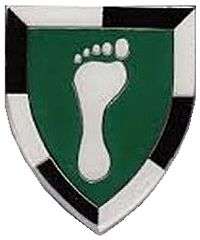1 SWA Specialist Unit
1 SWASpes was part of the South West African Territorial Force.[1]
| 1 SWA Specialist Unit | |
|---|---|
 SWATF 1 Spes emblem | |
| Active | 1977 |
| Country | |
| Allegiance | |
| Branch | |
| Type | Infantry |
| Part of | South West African Territorial Force |
| Garrison/HQ | Oshivello |
| Equipment | Casspir, Buffel |
| Commanders | |
| Current commander | Major David Mentz |
| Insignia | |
| Part of the South West African Territorial Force |  |
History
The South West African Territorial Force Command identified an urgent need for horse mounted and motorbike mounted units and dogs for the operational areas.
The conclusions reached was for a unit organisation such as 202 Battalion to be adjusted so as to accommodate horse and dog units for operational use, and specifically, the urgent need for the acquisition of two platoons of mounted infantry. This included the furnishing of horses and equine related equipment, as well as the training and appointing of a qualified platoon commanding officer, full-time veterinarian and farriers.
The Equestrian Centre became involved in the first purpose built frontline horse and motorcycle mounted infantry base in the Operational Area.
By 1978, 1 SWASpes had diversified into the application of motorcycles, trackers and later the introduction of tracking and explosives detection dogs. 1 SWASpes was among the first to combine conventional infantry forces on the ground with the skills of trackers, the abilities of dogs and the quick reaction abilities afforded by horses and motorcycle units.
Equestrian platoons were detached to bases across the Operational Area, though the main equestrian unit in South West Africa was stationed at Oshivelo.
1 SWASpes introduced to counter insurgency, the application of the Packhound; using dogs to track, run down, and corner quarry for infantry or mounted soldiers to interdict. These packs could keep a speed of 15 km for over four hours, peaking at 30 km for 15 minutes.
Organization
By 1978, it comprised two companies of mounted infantry, two platoons of trackers and two platoons of motorcyclists, and a force of 60 dogs. [2][3]
Roll of honour
- Colling, H. Rifleman 1980
- Beyleveld, M. Rifleman 1984
- Briggs, R.P. Corporal 1984
- Brindle, R.O. Rifeman 1981
- Dossenno Paul, Sergeant, 1977
- Devereaux, S.V.P. Rifleman, 1977
- Jordaan, H.K. Wrn 1981
- Mostert, A.D. Lance Corporal 1983
- Roos, D.N. Corporal 1979
- Mostert, E.C. Rifleman 1983
- Ross, T.A. Rifleman, 1983
- Venter, P.J. Wrn, 1981
- Swanepoel, P. Lance Corporal 1981
- Barth, A.C. Corporal 1984
See also
- Namibian War of Independence
- South African Border War
References
- "Introducing the SWATF" (PDF). Historicalpapers.wits.ac.za. Retrieved 10 November 2018.
- http://www.warinangola.com/Default.aspx?tabid=1239&Parameter=316
- Modern African Wars (3): South West Africa (Men-At-Arms Series, 242) by Helmoed-Romer Heitman, Osprey Publishing (28 November 1991) ISBN 1-85532-122-X and ISBN 978-1-85532-122-9
- "SA Roll of Honour: List People". Archived from the original on 2017-12-23. Retrieved 2018-11-10.
- Snyman, PHR (1989). "Beeld Van Die SWA Gebiedsmag". Archived from the original on 2014-11-07.
Further reading
- Helmoed-Romer Heitman (Author), Paul Hannon (Illustrator), Modern African Wars (3): South-West Africa (Men-At-Arms Series, 242), Osprey Publishing (November 28, 1991) ISBN 1-85532-122-X